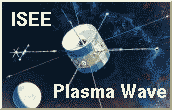 ISEE PROJECT
ISEE PROJECT
 ISEE PROJECT
ISEE PROJECT
The International Sun-Earth Explorer (ISEE) Program consisted of three satellites intended to study the Earth's magnetosphere and the solar wind. ISEE 1 and ISEE 2 were launched on October 22, 1977 into highly elliptical geocentric orbits. The satellites passed through the magnetosphere and into the magnetosheath during each orbit. ISEE 3 was launched on August 12, 1978 and subsequently inserted into a "halo orbit" about the the libration point situated about 240 earth radii (Re) upstream between the earth and the sun. Plasma passing this point arrives at the earth about one hour later where it may cause changes that can be observed by ISEE 1 and ISEE 2. These two spacecraft, separated by a variable distance and with similar instrument complements, were intended to resolve the space-time ambiguity associated with measurements by a single spacecraft on thin boundaries which may be in motion such as the bow shock and the magnetopause. ISEE 1 and ISEE 3 were the principal U. S. contributions to the International Magnetospheric Study. ISEE 2 was built and managed by the European Space Agency. In September 1982 ISEE 3 was diverted from its "halo orbit" to explore the earth's deep tail region through much of 1983 on its way to an encounter with the comet Giacobini Zinner in September 1985. ISEE 1 had a complement of thirteeen experiments to measure the waves, fields, plasma, and particles. The University of Iowa Plasma Wave Experiment was one of these thirteen. For further information on the ISEE project see the following references: